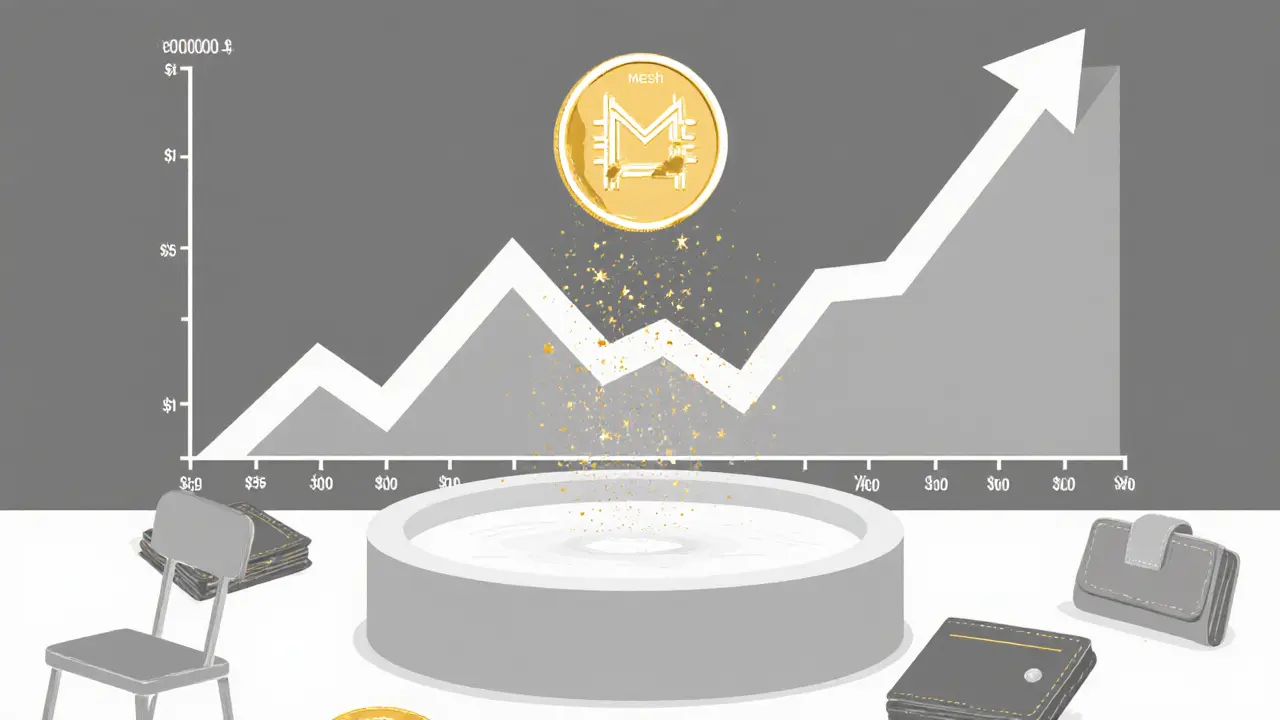Meshswap Crypto Exchange Review: Is This DeFi Platform Still Worth Your Time?
 May, 31 2025
May, 31 2025
MESH Token Value Calculator
Calculate Your MESH Token Value
See how much your MESH tokens would be worth today based on the dramatic price collapse.
Current Token Value
Results
Current Value: $0.00
Loss Percentage: 0.00%
Based on $5.01 peak price and current $0.0033 price
To break even, MESH would need to increase 0.00% from current price
When you hear "Meshswap," you might think of a fast, reliable crypto exchange like Uniswap or PancakeSwap. But the reality is far more complicated. Meshswap isn’t just another decentralized exchange-it’s a DeFi protocol that promised a new way to earn, govern, and grow with its native MESH token. But as of late 2025, that promise has faded. The token is trading near its all-time low, volume is barely visible, and the community has gone quiet. So, is Meshswap still worth your attention? Let’s break it down.
What Is Meshswap Really?
Meshswap launched as a DeFi platform built on the Polygon network, offering more than just token swaps. It combined AMM-based trading with lending, leverage farming, and staking-all tied to its token, MESH. The idea was simple: if you used the platform, you earned MESH. And if you held MESH, you helped decide how new farming pools were funded, how rewards were distributed, and even how much inflation the protocol would print each year.
Unlike most projects that sold tokens to insiders before launch, Meshswap did something different. It had a fair launch. No private sale. No VC backing. You had to provide liquidity to get MESH. That sounds fair. And for a while, it worked. Early adopters got in cheap, and the token surged to $5.01 in mid-2022.
The MESH Token: A Story of Collapse
Today, MESH trades at around $0.0033. That’s a 99.9% drop from its peak. You read that right. Almost all value has vanished.
Why? Because the model didn’t hold up. The platform relied on constant new money flowing in to pay rewards. As prices dropped and users left, the inflationary rewards couldn’t be sustained. The system started eating itself.
Here’s how it worked: when someone created a new farming pool, they had to burn MESH to pay for it. That was supposed to reduce supply and increase scarcity. But with so few people using the platform, the burn rate was tiny. Meanwhile, the circulating supply is still over 71 million tokens-far more than demand can absorb.
And here’s the kicker: the 24-hour trading volume is under $1,500. That’s less than what a single whale might move on Uniswap in five minutes. CoinMarketCap even labels Meshswap as an "Untracked Listing," meaning their data isn’t reliable. That’s not a red flag-it’s a flashing siren.
How Does Meshswap Compare to Other DeFi Exchanges?
Let’s be real: you don’t pick Meshswap because it’s the fastest or most liquid. You pick it because you believe in its tokenomics. But even that’s broken.
Compare it to the leaders:
- Uniswap: $1.2B+ daily volume, audited contracts, thousands of pools, and real institutional adoption.
- PancakeSwap: Built on BSC, handles millions in daily swaps, with a strong community and constant updates.
- Symbiosis.finance: Cross-chain swaps in under 45 seconds-faster than almost anything else.
Meshswap doesn’t rank among the top five fastest DeFi platforms. Its transaction speed? Unknown. Its security audits? Not published. Its team? Anonymous. Its roadmap? Gone.
There’s no transparency. No updates. No press releases. No Twitter activity beyond automated bot posts. The project feels abandoned.

Can You Still Earn With Meshswap?
Technically, yes. You can still stake MESH, provide liquidity, and earn more MESH. But here’s the problem: the rewards are shrinking.
With so little trading volume, the fee income going into reward pools is minimal. The inflationary emissions are still happening-but there’s no demand to absorb them. So what happens? The price drops further. It’s a death spiral.
And if you’re hoping to use MESH for governance? Good luck. Voting power is concentrated in a few wallets. The last meaningful proposal was over a year ago. The community isn’t just inactive-it’s gone.
Even the "complimentary airdrops" for vMESH holders? Unconfirmed. No one’s reporting receiving them. No proof. No screenshots. Just claims on a dead forum.
Price Predictions: Hope or Hype?
You’ll find blogs claiming MESH will hit $0.0016 by 2026. WalletInvestor says so. TradingBeast says so. But here’s the truth: these predictions are based on zero real data.
They’re using outdated trends, tiny sample sizes, and guesswork. When a token has less than $1,500 in daily volume, no algorithm can predict its future. It’s like trying to forecast the weather using a broken thermometer.
And if you’re thinking, "What if it rebounds?"-ask yourself: why would it? There’s no development team. No new features. No partnerships. No marketing. The project has been silent since early 2024.
Even in a bull market, when Bitcoin hit $70K in 2025, MESH barely moved. That’s not a recovery. That’s a corpse pretending to breathe.

Who Should Avoid Meshswap?
If you’re looking for:
- A safe place to swap tokens-avoid it.
- A high-yield DeFi opportunity-walk away.
- A project with active development-this isn’t it.
- A token with real utility or demand-MESH has none.
Even if you’re a speculative trader chasing dead coins, Meshswap is a bad bet. The liquidity is too thin. The slippage is high. And if you try to sell, you might not find a buyer at all.
What About the Future?
There’s no official roadmap. No GitHub commits. No Discord updates. No Telegram announcements. The website hasn’t changed in over 18 months.
Projects don’t come back from this kind of silence unless there’s a miracle. And miracles don’t happen in DeFi.
The only scenario where MESH might rise again is if a new team takes over, audits the contracts, burns half the supply, and rebuilds from scratch. But there’s zero evidence of that happening. And even if it did, you’d be investing in a completely new project-not the original Meshswap.
Final Verdict: Don’t Invest. Don’t Trade. Don’t Even Look Twice.
Meshswap was an ambitious idea. But ambition doesn’t replace execution. And in DeFi, execution is everything.
Today, Meshswap is a ghost. The token is nearly worthless. The platform is unused. The community is gone. The team has vanished.
If you’re holding MESH, consider it a learning experience. If you’re thinking of buying, don’t. There’s no upside. Only risk.
There are hundreds of better DeFi platforms out there-with real volume, active teams, and transparent tokenomics. Spend your time and money there. Not here.
Is Meshswap a safe crypto exchange to use?
No. Meshswap is not safe to use as a primary exchange. It has no published smart contract audits, no active development team, and extremely low trading volume. There’s a high risk of impermanent loss, slippage, and inability to exit your position. The platform is also labeled as "Untracked" by CoinMarketCap, meaning its data is unreliable.
Can I still earn rewards by staking MESH?
You technically can stake MESH and earn more tokens, but the rewards are minimal and unsustainable. With almost no trading volume, the fee income feeding the reward pools is negligible. The inflationary emissions are still happening, but without demand, the token price keeps falling. You’re essentially earning more of a worthless asset.
Why did MESH crash so hard?
MESH crashed because its tokenomics were based on a Ponzi-like model: new users had to keep joining and providing liquidity to pay rewards to existing users. Once the hype faded and users left, the system collapsed. The fair launch didn’t save it-without ongoing adoption, the token had no real value. The 99.9% drop from its peak reflects total loss of confidence.
Is there any chance MESH will recover in 2026?
Predictions of recovery are based on guesswork, not facts. With no team, no updates, no marketing, and no liquidity, there’s no logical reason for MESH to rise. Even optimistic forecasts only predict $0.0016 by 2026-still 99.5% below its peak. Real recovery requires active development, which hasn’t happened in over a year.
Where can I trade MESH?
MESH is only traded on the Meshswap DEX itself, primarily in the MESH/USDC.E and MESH/WPOL pairs. These pairs have combined daily volume under $1,500. There are no listings on major exchanges like Binance, Coinbase, or KuCoin. Liquidity is so low that even small sells can cause massive price drops.
Should I buy MESH if it’s cheap?
Buying MESH because it’s "cheap" is a trap. Price doesn’t equal value. A $0.0033 token with no demand, no utility, and no team is not a bargain-it’s a liability. You’re not buying an asset; you’re buying a gamble on a dead project. Save your money for projects with real traction.
Jennifer Morton-Riggs
November 22, 2025 AT 21:53Meshswap was never about utility-it was about the hype cycle. People chased yields without asking who’s paying for them. Classic DeFi folklore: if it sounds too good to be true, it’s probably a liquidity trap dressed up as innovation.
Gus Mitchener
November 23, 2025 AT 13:16The real tragedy isn’t the token dump-it’s the epistemological collapse of DeFi culture. When fair launches become just another vector for extractive speculation, we’re not building decentralized systems-we’re automating rent-seeking with smart contracts. MESH didn’t fail because of bad code; it failed because the social contract collapsed under the weight of its own incentive misalignment.
Kathy Alexander
November 24, 2025 AT 07:10People still think this is worth discussing? The volume’s lower than my last Tinder match’s engagement. If you’re still holding MESH, you’re not an investor-you’re a museum piece.
Soham Kulkarni
November 25, 2025 AT 10:55i know some folks in india who still hold mesh... they say they believe in the vision. but honestly, i think they just dont wanna admit they lost money. its hard to let go, i get it. but maybe its time to cut losses and move on.
Dave Sorrell
November 25, 2025 AT 14:37Meshswap’s collapse follows a textbook pattern seen in dozens of failed DeFi protocols: unsustainable yield mechanics, zero transparency, and no development activity. The tokenomics were fundamentally broken from day one. Even with a fair launch, if the economic model can’t sustain itself without constant inflows, it’s a Ponzi by definition. Don’t confuse fairness with viability.